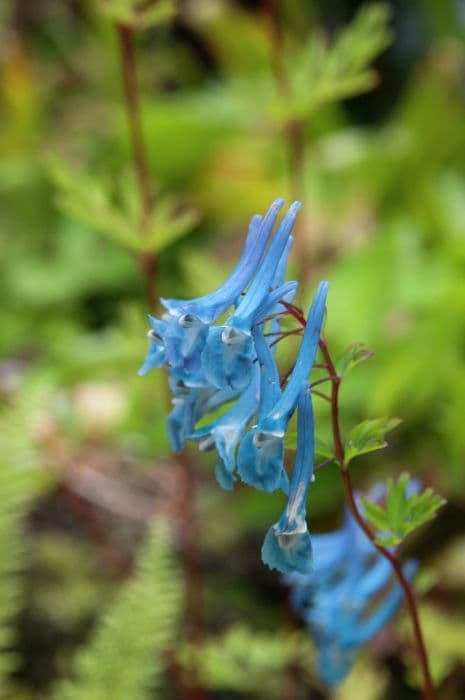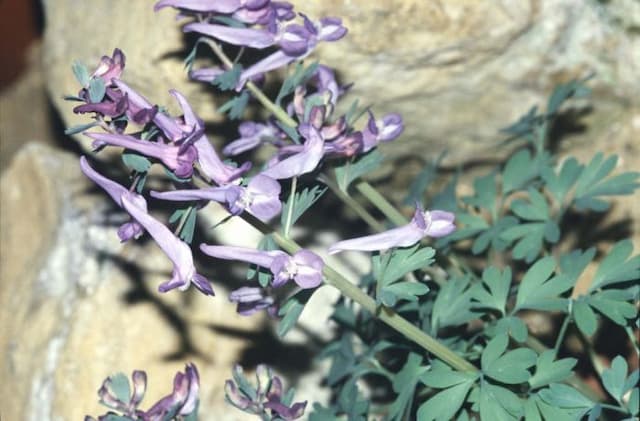Himalayan Blue Poppy Meconopsis 'Keillour'

ABOUT
The Meconopsis 'Keillour', often referred to as the 'Blue Poppy', presents a captivating display with its strikingly vibrant, blue flowers that are a rarity in the floral world. The petals display a subtle silkiness and are delicately arranged in a cup-like shape, creating a stunning visual spectacle. At the center of each bloom, there's a cluster of prominent yellow stamens that contrast vividly with the cool blue of the petals, adding an extra layer of allure to the flower's appearance. The foliage of the Blue Poppy is no less attractive, with leaves that possess a rich green hue and a somewhat hairy texture, contributing to the overall lush appearance of the plant. These leaves form a rosette at the base, providing a verdant backdrop for the ethereal blue of the blossoms. The Meconopsis 'Keillour' blooms in the late spring to early summer, putting on a show when the garden most eagerly embraces color. Each flower stands out against the greenery with a poise that will surely draw the eye and capture the hearts of gardeners and passersby alike.
About this plant
 Names
NamesFamily
Papaveraceae
Synonyms
Keillour Blue Poppy, Himalayan Blue Poppy, Tibetan Blue Poppy
Common names
Meconopsis 'Keillour'.
 Toxicity
ToxicityTo humans
The Meconopsis 'Keillour', commonly known as Himalayan blue poppy, is not widely recognized as a toxic plant to humans. There is limited information on severe toxicity or poisoning from ingesting this plant. However, as with any plant, it's always prudent to exercise caution and avoid ingestion since individual sensitivities can vary, and there might be a lack of comprehensive research on possible toxic compounds present in the species.
To pets
The Himalayan blue poppy is not known for being poisonous to pets. However, the absence of widespread recognition of toxicity does not guarantee that the plant is completely safe. The ingestion of plant material by pets could potentially lead to gastrointestinal upset or other symptoms due to individual intolerances or allergies. Therefore, it is recommended to prevent pets from consuming any part of the plant and to consult a veterinarian if ingestion occurs and any adverse reactions are observed.
 Characteristics
CharacteristicsLife cycle
Perennials
Foliage type
Deciduous
Color of leaves
Green
Flower color
Blue
Height
4 feet [1.2 meters]
Spread
2 feet [0.6 meters]
Plant type
Herb
Hardiness zones
5
Native area
Himalayas
Benefits
 General Benefits
General Benefits- Aesthetic Appeal: Meconopsis 'Keillour', commonly known as Himalayan Blue Poppy, adds a vibrant blue hue that can serve as a stunning focal point in gardens and landscapes.
- Pollinator Attraction: It attracts bees and other pollinators, which are vital for the pollination of many plants and the overall health of the ecosystem.
- Habitat Enrichment: Provides food and habitat for insect larva, contributing to the biodiversity and ecological balance in the garden.
- Versatile Landscaping: Due to its striking color and unique appearance, it can be used in a variety of garden styles including rockeries, woodland gardens, and borders.
- Seasonal Interest: Blooms in late spring or early summer, offering seasonal interest and variety in gardens that might otherwise be dominated by green foliage.
 Medical Properties
Medical PropertiesThis plant is not used for medical purposes.
 Air-purifying Qualities
Air-purifying QualitiesThis plant is not specifically known for air purifying qualities.
 Other Uses
Other Uses- Photography Subject: The vibrant colors and unique appearance of Meconopsis 'Keillour', commonly known as Blue Poppy, make it an excellent subject for botanical photography and garden portfolios.
- Artistic Inspiration: Artists may use the striking form and color of the Blue Poppy as inspiration for paintings, illustrations, and textile designs.
- Educational Tool: Botanical gardens and educators can use the Blue Poppy to teach about plant biology, particularly the adaptations of alpine plants.
- Garden Design: The Blue Poppy can be used as a focal point in garden design, particularly in rock gardens and woodland settings where they thrive.
- Eco-friendly Dye: The petals of the Blue Poppy could potentially be used to create natural fabric dyes, contributing to sustainable fashion initiatives.
- Cultural Festivals: In regions where the Blue Poppy is a native species, it could be celebrated during local festivals to raise awareness and appreciation for indigenous flora.
- Motif in Decor: The image of the Blue Poppy can be used as a decorative motif in home décor items such as wallpapers, cushions, and ceramics.
- Bee Attraction: Blue Poppies can be integrated into gardens that aim to attract and support pollinators, such as bees, aiding in the conservation of these essential insects.
- Conservation Symbol: The Blue Poppy, due to its uncommonness, could serve as a symbol for plant conservation efforts and the importance of preserving biodiversity.
- Relaxation Aid: The serene and calming visual effect of the Blue Poppy’s bloom can be utilized in therapeutic gardens designed for relaxation and stress relief.
Interesting Facts
 Feng Shui
Feng ShuiThe Blue Poppy is not used in Feng Shui practice.
 Zodiac Sign Compitability
Zodiac Sign CompitabilityThe Blue Poppy is not used in astrology practice.
 Plant Symbolism
Plant Symbolism- Transcendence - Meconopsis 'Keillour', more commonly known as Blue Poppy, often symbolizes the quest for knowledge and truth because of its ethereal blue color, which is rare in the natural world of flowers.
- Peace - The serene appearance of the Blue Poppy gives it an association with peace, calmness, and tranquility.
- Success - In some cultures, the rarity and difficulty of growing Blue Poppies make them a symbol of success, especially after overcoming challenges.
- Dreams - The captivating and somewhat dreamy appearance of this plant can represent dreaming and the realm of imagination.
 Water
WaterThe Blue Poppy should be watered deeply but infrequently to mimic its native environment. Ensure the soil remains evenly moist, but not waterlogged, allowing the top inch of soil to dry out slightly between waterings. Typically, this might mean watering once every week with roughly 1 to 2 gallons, depending on climate conditions, especially during the growing season. During winter dormancy, reduce watering to every other week, being cautious not to let the roots dry out completely.
 Light
LightBlue Poppies require dappled sunlight to partial shade, preferring a spot that is sheltered from the intense heat of the afternoon sun. Bright, indirect light for several hours a day is ideal; morning sunlight is beneficial as long as the plant is protected from strong midday rays. Provide a location that offers light shade to ensure healthy growth and flower development.
 Temperature
TemperatureBlue Poppies thrive best in cooler temperatures, ideally between 50°F and 65°F. They can tolerate a temperature range of approximately 40°F to 70°F. Avoid placing Blue Poppies in areas where temperatures exceed 75°F as high heat can be detrimental to their health and blooming capability.
 Pruning
PruningPruning the Blue Poppy is generally done to remove spent flowers and encourage additional blooming or to cut back foliage in late fall when plants begin to die back. The best time for pruning is after flowering has completed in the summer or in late autumn before winter dormancy sets in. Deadheading should be done regularly to prolong the flowering period.
 Cleaning
CleaningAs needed
 Soil
SoilThe Himalayan Blue Poppy requires a rich, well-draining soil with a high organic matter content. An ideal soil mix for this plant includes a blend of peat moss, leaf mold, and loam, with a pH of slightly acidic to neutral (pH 6.0-7.0). Good drainage is crucial to avoid root rot.
 Repotting
RepottingHimalayan Blue Poppies should be repotted every one to two years to replenish the soil and accommodate root growth. Being careful with their delicate roots is important during repotting.
 Humidity & Misting
Humidity & MistingHimalayan Blue Poppies thrive best in a high humidity environment. The ideal humidity level for this plant ranges from 50% to 70%, mimicking its natural humid mountain habitats.
 Suitable locations
Suitable locationsIndoor
Provide bright, indirect light and cool temps.
Outdoor
Plant in dappled shade, shelter from harsh sun.
Hardiness zone
5-7 USDA
 Life cycle
Life cycleMeconopsis 'Keillour', commonly known as the Keillour Hybrid Himalayan Blue Poppy, begins its life cycle as a seed, which upon germination—typically in cool, damp soil—develops into a rosette of leaves. The plant's vegetative stage is characterized by lush, green foliage, where it focuses on growth and energy accumulation. In its flowering stage, usually in the late spring or early summer of the second year after sowing, Meconopsis 'Keillour' produces striking blue flowers that attract pollinators and may sometimes repeat flowering in subsequent years. After pollination, these flowers develop into seed capsules that release seeds, ensuring the propagation of the next generation. Once the plant has flowered, it may die back, as many species in the genus Meconopsis are monocarpic, meaning they die after setting seed. However, some plants may survive and vegetatively produce new leaf rosettes, continuing their life cycle for several years.
 Propogation
PropogationPropogation time
Spring-Early Summer
The most popular method of propagation for the Meconopsis 'Keillour', commonly known as the Himalayan Blue Poppy, is by seed. Propagation by seed is usually performed in late winter to early spring. To propagate, fresh seeds should be sown on the surface of a moist, well-drained seed compost mix in a pot or tray. It's important not to cover the seeds with compost because they require light for germination. The container should be placed in a cool environment, around 50 degrees Fahrenheit (10 degrees Celsius), and kept out of direct sunlight. Germination can be slow and erratic, but once the seedlings are large enough to handle, they can be transplanted into individual pots. Care should be taken not to disturb the roots too much during transplanting.









